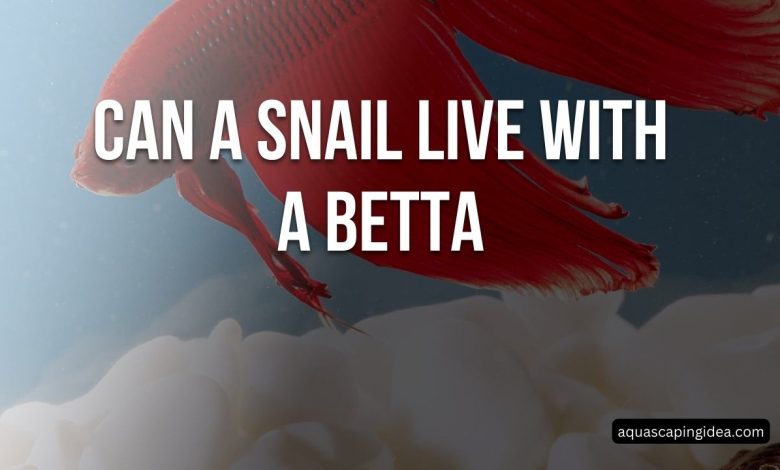Can A Snail Live With A Betta

Snails and betta fish rank among the most common freshwater aquarium animals. Peaceful betta personalities and snails’ clean-up services seem to make them the perfect community tank match. However, looks can be deceiving. Not all snail and betta combinations end well.
Do Betta Fish and Snails Make Good Tankmates?
Whether the pairing succeeds or fails comes down to species selection, tank size, population ratios, and individual betta temperament. When the conditions are right, snails and bettas can mutually thrive. If requirements are ignored, one or both may succumb to aggressive attacks or declining environmental conditions. This article will delve into ideal setups, proper species combinations, signs of trouble, and frequently asked questions to settle the debate on snail and betta compatibility once and for all.
Best Snails for Betta Tanks
Hundreds of unique freshwater snail varieties exist, but only a handful make suitable betta tankmates. Stick to selecting small, peaceful species to lower chances of aggression or accidental injury. The following meet the size and activity level requirements for healthy betta cohabitating.
Nerite Snails
These 1⁄2 to 1 inch molluscs live in brackish water across Southeast Asia and Africa. Their shades closely resemble natural habitat decor like smooth stones or driftwood. Though nerites stay small, they efficiently clean tanks of excess algae and debris. Their intricate shell markings and peaceful temperaments make them prime candidates for betta introductions.
Ramshorn Snails
Both the timeless red shade and more ornately spotted color morphs of these snails crawl through many betta neighborhood rice paddies and waterways abroad. Growing no more than 1 inch maximum, they consume various algaes and rarely bother tankmates. Their shallow whorled shells safely pass by elaborate fins.
Malaysian Trumpet Snails
These industrious algae and detritus consumers thrive by borrowing through substrate, aerating sediments in the process. Their conical shells reach just over 1⁄2 inch long but slim profiles help avoid potential aggression issues. Trumpet snails also live and reproduce rapidly enough to form reliable clean up crews.
Selecting Suitable Betta Tankmates
Betta personality plays a pivotal role in determining snail compatibility success. Aggression levels vary tremendously among individuals regardless of factors like age, gender, or tail type. However, certain types tend to show less hostile tendencies, improving odds for peaceful integration.
Older bettas often lose previous territorial instincts and become more docile. Short-finned female and plakat varieties avoid lengthy tails snails could potentially latch onto. And underbred bettas retain mellower wild tendencies.
Observe any prospective betta’s behavior for at least two weeks in a species only tank first. Pass on candidates who chase reflections obsessively or regularly flare unprovoked at deco or their own reflections. Instead pick fish that spend most time resting quietly or playing gently with toys.
Ideal Habitat Layouts
Habitat structure also sways outcomes when attempting mixed betta-snail situations. Prevent aggression and interference by providing adequate swimming lanes plus visual barriers:
- 10+ gallon tanks
- Plenty of silk plants dividing open areas
- Driftwood tunnels and rock caves
- Lower bioload via minimal tankmates
- Gentle filter flow pathways
Continue monitoring all inhabitants’ behavior closely regardless of selections or tank shape. Remove aggressors at first signs of trouble before injuries occur.
Signs of Stress and Incompatibility
Look for these clues that harmony is failing despite best efforts:
Snails:
- Retreat into shells often when approached
- Clustering high on structures above the substrate
- Damage to eyestalks or tentacles
- Missing antennae
- Large unhealed chips in shells
Bettas:
- Flaring gill covers when snails draw near
- Nipping mollusc eyestalks
- Bumping snails off surfaces
- Damaged fins from hunting attempts
Rising nitrates from increased bioload pushes all inhabitants’ stress even if no obvious aggression emerges. React to red flags immediately by isolating the betta and providing supplemental feeding for a stronger clean up crew.
Frequently Asked Questions
Will adding salt or aquarium medicines hurt snails?
A: Most treatments are toxic, especially to more delicate species like ramshorns. Quarantine sick bettas when using remedies.
Are “pest” snails ok with bettas?
A: Small wild hitchhikers like bladder snails fare well with passive bettas. Their reproduction mustn’t overload capacity plus provide adequate food.
Should I remove snail eggs so the tank doesn’t get overrun?
A: Manually removing egg clutches helps control populations. Alternatively, limiting food curbs excessive breeding provided new hatchlings can access enough resources.
Will bettas eat baby snails?
A: Possibly, though many ignore tiny snails if plenty of other foods are given. Provide vegetable matter, algae wafers and calcium-rich pellets to reduce temptation.
Conclusion
In the wild, bettas and snails peacefully coexist in the same warm shallow waters across Southeast Asia. Recreating naturalistic habitats balanced to meet both species’ needs enables that harmony to continue captively. Make conservation-minded choices when selecting tankmates to craft ethical, educational displays. With proper planning, attentive animal husbandry, and quick conflict intervention, the micro ecosystems bettas and snails share can easily translate into wonderful home aquariums. So consider blending these fascinating creatures to make beautifully balanced betta tanks.




